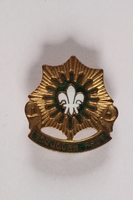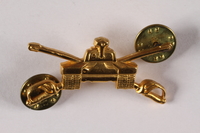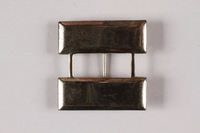Overview
- Description
- The Morgenthau family collection documents the interpersonal relationships between members of the family of Henry Jr. and Elinor Morgenthau and their children, Henry III, Robert, and Joan.
Series 1, a chronological series, includes family documents, miscellaneous correspondence, clippings, school papers, publications, invitations, calling cards, business materials, photographs, and other ephemera collected by members of the family throughout the 20th century. Henry Morgenthau III is the nexus of the collection; therefore many of the documents from the 1930s relate to his schooling, the 1940s relate to his wartime military service, and post-war folders to his business ventures and work with public radio and television. The 1930s include his diary written on a trip to Europe, including references to meetings with Ambassadors Steinhardt and Bullit, and conversations with Martha Dodd. The folders related to Princeton University include an anonymous anti-Semitic note sent to Henry III, and the folders related to the late 1930s include correspondence from Herbert Lehman, governor of New York, to his niece, Elinor Morgenthau, about sponsoring German relatives seeking to immigrate from Nazi Germany.
Series 2 contains personal correspondence between members of the family. This series includes love letters between Henry Morgenthau Jr. and Elinor Fatman prior to their marriage, including letters sent from Henry while visiting his father while Henry Sr. was stationed in Constantinople (now Istanbul). The correspondence clearly shows how close the family remained, even after the children in college and serving in the military. Letters between Henry Morgenthau Sr. and Henry Morgenthau, Jr. in 1933-1936 include personal business discussions, as well as materials sent to father and son, including correspondence from people in Germany seeking assistance with immigration. In 1944-1945, Henry Morgenthau Jr. dictated letters to his sons about projects at the Treasury Department, including War Bonds, Bretton Woods, and the Morgenthau Plan for post-war Germany. As Elinor Morgenthau was hospitalized in Florida from March-May 1945, Henry’s correspondence to her and to his children document his personal feelings about the end of the war, the death of Franklin Roosevelt, Harry Truman, and his resignation from the Treasury Department in July 1945.
Series 3 includes invitations and parking instructions sent to Henry Morgenthau III for White House functions and dinners, most of them informal. This series also includes tickets to inaugural events for Franklin Roosevelt and for Herbert Lehman, as well as original and copies of correspondence between the Roosevelts and Morgenthaus, dating from 1914-1963.
Series 4 contains materials collected or created by Henry Morgenthau, III, while researching his manuscript, “Mostly Morgenthaus.” The collection includes transcripts of oral histories conducted by Morgenthau with members of his extended family, with Treasury Department staff members, and with family friends. This series also includes original correspondence and documents related to these individuals.
Series 5 relates to the actual research, writing, and publication of “Mostly Morgenthaus,” written by Henry Morgenthau III, which was published by Ticknor and Fields in 1991. Subseries 1, the research series, includes extensive family research, correspondence, clippings, articles, photocopies of archival documents, handwritten and typed notes, and other material gathered prior to writing the text of the book. Subseries 2 includes drafts of various chapters and of the manuscript as a whole. Subseries 3 relates to the actual editing, publication, and publicity surrounding the book.
Series 6 includes a series Colliers magazine articles written by Henry Morgenthau, Jr. in 1947, a New York Times magazine article written by Henry Morgenthau, Jr. in 1949, and a “Mostly Morgenthaus” galley.
Series 7, consisting of digital copies of typed memoirs written by Henry Morgenthau III, is restricted.
Series 8 through 11 consist of photographic materials, albums, and scrapbooks documenting the Morgenthau family and their personal and professional lives. There is a great deal of overlap among these series in terms of subjects, individuals, and events.
Series 8 contains personal and official photographs of members of the Morgenthau family, friends, and colleagues and significant locations in Morgenthau family history. Individuals include Henry Morgenthau, Sr.; Henry Morgenthau, Jr.; Henry Morgenthau III; Lazarus, Josephine, Alma, Elinor, Robert, Joan, and Ruth Morgenthau; Franklin and Eleanor Roosevelt; John F. Kennedy; Treasury Department officials; and Marlene Dietrich. Locations include Krumbach, Germany, Goodhart family home, Fishkill Farms, and Hupfel House.
Series 9 includes miscellaneous photographs, negatives, and corresponding materials. They depict some of the people in Series 8 and document Princeton summer camp, Deerfield Academy, and travel to Luxembourg, Greece, Germany, the United Kingdom, Athens, Munich, United Kingdom, Martha’s Vineyard, Jamaica, France, and Sri Lanka.
Series 10 contains oversize photographs, photograph albums, and scrapbooks including photographs and newspaper clippings documenting many of the people in Series 8 and Series 9 as well as Morris and Lisette Fatman, Msgr John Patrick Carroll-Abbing, the Mayer Lehman family, Harriet Haas, and Roosevelt’s cabinet members. Photographs also depict a November 1945 dinner honoring Henry Morgenthau, Jr. and travel to Israel, Arizona, Greece, Cleveland, Canada, and Alaska. - Date
-
inclusive:
1860-2005
bulk: 1930-1950
- Credit Line
- United States Holocaust Memorial Museum Collection, Gift of Henry Morgenthau III
- Collection Creator
- Henry Morgenthau III
Henry Morgenthau Jr. - Biography
-
Henry Morgenthau III was born on January 11, 1917, to Henry Morgenthau, Jr. and Elinor Fatman Morgenthau. He had a younger brother Robert, born in 1919, and a younger sister Joan, born in 1922. The family lived in Hyde Park, NY. His father (1986-1967) was US Secretary of the Treasury during the Roosevelt administration, 1932 - July 1945. After graduating from Princeton University in 1939, Henry worked for two years on public housing issues in Cleveland, Ohio. The United States declared war on Germany and Japan in December 1941. Morgenthau joined the United States Army. In 1943, he graduated from the 24th Cavalry Officer candidate school as a 2nd Lieutenant. Lt. Morgenthau deployed to the European Theater. At some point, he transferred to the Second Cavalry. He fought in the Battle of the Bulge and was awarded the Bronze Star for meritorious service. The war ended in May 1945. After his return to the US, Morgenthau resumed his work on public housing issues. He became involved in theater, working with the New Dramatists, and with public radio and television. In 1962, he married Ruth Schachter, who had fled Austria at age nine with her family in 1940. The couple had three children. They settled in Cambridge, MA, and were involved in many philanthropic endeavors. Henry spent most of his career with public television broadcaster WGBH. Ruth, who held a PhD in African politics, was a professor at Brandeis University. Ruth, 75, passed away in 2006.
Henry Morgenthau, Jr. was born on May 11, 1891 in New York, NY, and was raised in a secular German Jewish family. His father, Henry Morgenthau, Sr., was appointed Wilson’s ambassador to the Ottoman Empire, 1913-1916, and Henry Jr. visited his father in Istanbul. Though Henry attended Cornell University, he did not graduate but instead bought a large farm in Dutchess County, NY, near the home of Franklin Roosevelt. The two men became friends. In 1916, Henry met and married Elinor Fatman; the couple had three children: Henry III (b. 1917), Robert (b. 1919), and Joan (1922-2012). Henry intended to make a living as a farmer, and also published the American Agriculturalist magazine. When Roosevelt was elected governor, Henry was appointed to an agricultural advisory committee. In 1934, on the death of Roosevelt’s Secretary of the Treasury, Morgenthau was appointed to the position. After his resignation in July 1945, Morgenthau became more heavily involved in Jewish affairs. He became General Chairman of the United Jewish Appeal and was a financial advisor to the newly-created state of Israel. “Tal Shahar,” an agricultural community near Jerusalem, was named in his honor. After Elinor’s death in 1949, Morgenthau married Marcelle Morgenthau in 1952. He passed away in 1967.
Physical Details
- Language
- English
- Genre/Form
- Photographs. Photograph albums. Scrapbooks. Correspondence.
- Extent
-
61 boxes
15 oversize boxes
- System of Arrangement
- The collection is arranged in eleven series, largely retaining the donor’s original order, with series four divided into three subseries:
•Series 1: Family papers, 1860-2008
•Series 2: Family correspondence, 1905-1961
•Series 3: Material related to the relationship between the Roosevelts and Morgenthaus, 1914-1963
•Series 4: Oral history transcripts and correspondence with individuals, approximately 1941-2002
•Series 5: Materials related to “Mostly Morgenthaus,” 1876-1992
oSubseries 1: Research for “Mostly Morgenthaus,” 1876-1985
oSubseries 2: Drafts of “Mostly Morgenthaus,” 1986-1992
oSubseries 3: Publication of “Mostly Morgenthaus,” 1984-1992
•Series 6: Magazine articles by Henry Morgenthau, Jr. and “Mostly Morgenthaus” galley, 1947-1991
•Series 7: Henry Morgenthau III memoirs, 1997-2015
•Series 8: Loose Photographs, approximately 1890-2010
•Series 9: Miscellaneous photographs, negatives, and corresponding materials, approximately 1900-2003
•Series 10: Oversize photographs and photograph albums, approximately 1860-1980
•Series 11: Photographs, albums, and scrapbooks, 1889-2009
Series 1 and 3 are organized chronologically. Series 2 and 4 are arranged alphabetically by author and therein chronologically. Series 5 is organized thematically, in rough chronological order by topic.
Researchers are advised that series 1, 2, and 4 contain many individual and thematic overlaps. For example, the type of “Family correspondence” typically found in Series 2, can also be located, to a smaller degree, in the chronologically arranged files of “Family papers” in Series 1, so both series should be examined. Likewise, the photographs, albums, and scrapbooks in series 8, 9, 10, and 11 contain many individual and thematic overlaps.
Rights & Restrictions
- Conditions on Access
- Series 7, the donor's memoirs, are restricted during his lifetime and thereafter subject to a twenty-five year restriction. Access to specified sections can be lifted only with written permission from Kramer Morgenthau or Mizia Wessel (after she turns 21 years old.) During this period, Bonnie Naradzay, Vincent Grenata, and David Keplinger are exempted from the restriction, and may view the contents of series 7. All other materials are open for access.
- Conditions on Use
- Donor retains copyright on materials created by members of his family. Other materials may be under copyright. The user is solely responsible for making a determination as to if and how the material may be used.
- Copyright Holder
- Henry Morgenthau III
Keywords & Subjects
- Topical Term
- Armenian massacres, 1915-1923. Holocaust, Jewish (1939-1945)--United States. Jews--United States. Jews in public life--United States. United States--Politics and government--20th century. United States--Foreign relations--20th century. World War, 1914-1918--Atrocities--Turkey. World War, 1939-1945--Economic aspects--United States. World War, 1939-1945--War work--United States. Executive departments
- Geographic Name
- Hyde Park (Dutchess County, N.Y.) Boston (Mass.) United States
Administrative Notes
- Holder of Originals
-
United States Holocaust Memorial Museum
- Legal Status
- Permanent Collection
- Provenance
- Henry Morgenthau III donated his family's collection to the United States Holocaust Memorial Museum in 2015.
- Record last modified:
- 2023-10-20 13:37:49
- This page:
- https://collections.ushmm.org/search/catalog/irn96059
Additional Resources
Download & Licensing
In-Person Research
- Available for Research
- Plan a Research Visit
-
Request in Shapell Center Reading Room
Bowie, MD
Contact Us
Also in Henry Morgenthau family collection
The collection consists of artifacts, extensive personal and official correspondence, documents, photographs, research notes, audiotapes, books, and a DVD copy of home movies related to the experiences of the Morgenthau family. The collection includes material related to the Ottoman Empire and Armenian genocide, the family's long relationship with the Roosevelts, the Treasury Department, and the pre-war, wartime, and post-war lives of members of the family as well as family history research, collected documents, and transcripts of oral histories created and compiled by Henry Morgenthau III.
Date: 1870-2005

Bronze Star medal with box and certificate awarded to a Jewish American soldier
Object
Bronze Star medal and ribbon with presentation box and certificate awarded to Henry Morgenthau III, an officer in the United States Army, Second Cavalry, for meritorious service during combat from January 1, 1945 to February 28, 1945, in Luxemburg.

Two dog tags and a chain worn by a Jewish American soldier
Object
Two identical dog tags on a chain issued to Henry Morgenthau III, an officer in the United States Army, Second Cavalry, ca. 1941-1945. He served in combat in the European theater and was awarded a Bronze Star for meritorious service.

US Army 2nd Cavalry Regiment Toujours Pret pin worn by a Jewish American soldier
Object
Clutchback pin with the motto Toujours Pret (Always Ready) worn by Henry Morgenthau III, an officer in the United States Army, Second Cavalry, ca. 1941-1945. He served in combat in the European theater and was awarded a Bronze Star for meritorious service.

US Army 2nd Cavalry regimental pin worn by a Jewish American soldier
Object
Second Cavalry regimental crossed sabers pin worn by Henry Morgenthau III, who was an officer in the United States Army, Second Cavalry, ca. 1941-1945. He served in combat in the European theater and was awarded a Bronze Star for meritorious service.

US Army 2nd Cavalry captain's insignia worn by a Jewish American soldier
Object
US Army captain's insignia pin worn by Henry Morgenthau III, who was an officer in the United States Army, Second Cavalry, ca. 1941-1945. He served in combat in the European theater and was awarded a Bronze Star for meritorious service.

Waffen-SS Mountain Troop patch acquired by a US soldier
Object
Waffen-SS Mountain Troop edelweiss badge acquired by Henry Morgenthau III, an officer in the United States Army, Second Cavalry, ca. 1941-1945. He served in combat in the European theater and was awarded a Bronze Star for meritorious service.
Vote for Morgenthau sash
Object
Vote for Morgenthau sash owned by Henry Morgenthau III, who was an officer in the United States Army, Second Cavalry, ca. 1941-1945. He served in combat in the European theater and was awarded a Bronze Star for meritorious service.
Embroidered tablecloth
Object
Tablecloth owned by Henry Morgenthau III, who was an officer in the United States Army, Second Cavalry, ca. 1941-1945. He served in combat in the European theater and was awarded a Bronze Star for meritorious service.
Name Badge and Ribbon
Object



